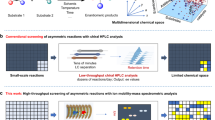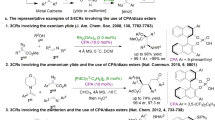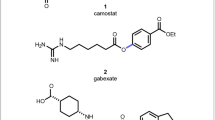Abstract
Multicomponent reactions are employed extensively in many areas of organic chemistry. Despite significant progress, the discovery of such enabling transformations remains challenging. Here, we present the development of a parallel, label-free reaction-discovery platform that can be used in the identification of new multicomponent transformations. Our approach is based on parallel mass spectrometric screening of interfacial chemical reactions on arrays of self-assembled monolayers. This strategy enabled the identification of a simple organic phosphine that can catalyse a previously unknown condensation of siloxyalkynes, aldehydes and amines to produce 3-hydroxyamides with high efficiency and diastereoselectivity. The reaction was further optimized using solution-phase methods.
This is a preview of subscription content, access via your institution
Access options
Subscribe to this journal
Receive 12 print issues and online access
$259.00 per year
only $21.58 per issue
Buy this article
- Purchase on Springer Link
- Instant access to full article PDF
Prices may be subject to local taxes which are calculated during checkout



Similar content being viewed by others
References
Menger, F. M., Eliseev, A. V. & Migulin, V. A. Phosphatase catalysis via combinatorial organic chemistry. J. Org. Chem. 60, 6666–6661 (1995).
Liu, G. & Ellman, J. A. A general solid-phase synthesis strategy for the preparation of 2-pyrrolidinemethanol ligands. J. Org. Chem. 60, 7712–7713 (1995).
Burgess, K., Lim, H-J., Porte, A. M. & Sulikowski, G. A. New catalysts and conditions for a C–H insertion reaction identified by high-throughput catalyst screening. Angew. Chem. Int. Ed. Engl. 35, 220–222 (1996).
Cole, B. M. et al. Discovery of chiral catalysts through ligand diversity: Ti-catalyzed enantioselective addition of TMSCN to meso epoxides. Angew. Chem. Int. Ed. Engl. 35, 1668–1671 (1996).
Francis, M. B., Finney, N. S. & Jacobsen, E. N. Combinatorial approach to the discovery of novel coordination complexes. J. Am. Chem. Soc. 118, 8983–8984 (1996).
Taylor, S. J. & Morken, J. P. Thermographic selection of effective catalysts from an encoded polymer-bound library. Science 280, 267–270 (1998).
Reetz, M. T., Becker, M. H., Kühling, K. M. & Holzwarth, A. Time-resolved IR-thermographic detection and screening of enantioselectivity in catalytic reactions. Angew. Chem. Int. Ed. 37, 2647–2650 (1998).
Senkan, S. M. High-throughput screening of solid-state catalyst libraries. Nature 394, 350–353 (1998).
Reddington, E. et al. Combinatorial electrochemistry: a highly parallel, optical screening method for discovery of better electrocatalysts. Science 280, 1735–1737 (1998).
Sigman, M. S. & Jacobsen, E. N. Schiff base catalysts for the asymmetric Strecker reaction identified and optimized from parallel synthetic libraries. J. Am. Chem. Soc. 120, 4901–4902 (1998).
Cooper, A. C., McAlexander, L. H., Lee, D-H., Torres, M. T. & Crabtree, R. H. Reactive dyes as a method for rapid screening of homogeneous catalysts. J. Am. Chem. Soc. 120, 9971–9972 (1998).
Shaughnessy, K. H., Kim, P. & Hartwig, J. F. A fluorescence-based assay for high-throughput screening of coupling reactions. Application to Heck chemistry. J. Am. Chem. Soc. 121, 2123–2132 (1999).
Copeland, G. T. & Miller, S. J. A chemosensor-based approach to catalyst discovery in solution and on solid support. J. Am. Chem. Soc. 121, 4306–4307 (1999).
Berkowitz, D. B., Bose, M. & Choi, S. In situ enzymatic screening (ISES): a tool for catalyst discovery and reaction development. Angew. Chem. Int. Ed. 41, 1603–1607 (2002).
Stauffer, S. R. & Hartwig, J. F. Fluorescence resonance energy transfer (FRET) as a high-throughput assay for coupling reactions. Arylation of amines as a case study. J. Am. Chem. Soc. 125, 6977–6985 (2003).
Yao, S., Meng, J-C., Siuzdak, G. & Finn, M. G. New catalysts for the asymmetric hydrosilylation of ketones discovered by mass spectrometry screening. J. Org. Chem. 68, 2540–2546 (2003).
Chen, P. Electrospray ionization tandem mass spectrometry in high-throughput screening of homogeneous catalysts. Angew. Chem. Int. Ed. 42, 2832–2847 (2003).
Teichert, T. & Pfaltz, A. Mass spectrometric screening of enantioselective Diels–Alder reactions. Angew. Chem. Int. Ed. 47, 3360–3362 (2008).
Wassenaar, J. et al. Catalyst selection based on intermediate stability measured by mass spectrometry. Nature Chem. 2, 417–421 (2010).
Kanan, M. W., Rozenman, M. M., Sakurai, K., Snyder, T. M. & Liu, D. R. Reaction discovery enabled by DNA-templated synthesis and in vitro selection. Nature 431, 545–549 (2004).
Rozenman, M. M., Kanan, M. W. & Liu, D. R. Development and initial application of a hybridization-independent, DNA-encoded reaction discovery system compatible with organic solvents. J. Am. Chem. Soc. 129, 14933–14938 (2007).
Chen, Y., Kamlet, A. S., Steinman, J. B. & Liu, D. R. A biomolecule-compatible visible light-induced azide reduction from a DNA-encoded reaction discovery system. Nature Chem. 3, 146–153 (2011).
Beeler, A. B., Su, S., Singleton, C. A. & Porco, J. A. Jr Discovery of chemical reactions through multidimensional screening. J. Am. Chem. Soc. 129, 1413–1419 (2007).
Goodell, J. R. et al. Development of an automated microfluidic reaction platform for multidimensional screening: reaction discovery employing bicyclo[3.2.1]octanoid scaffolds. J. Org. Chem. 74, 6169–6180 (2009).
Robbins, D. W. & Hartwig, J. F. A simple, multidimensional approach to high-throughput discovery of catalytic reactions. Science 333, 1423–1427 (2011).
Min, D-H., Yeo, W-S. & Mrksich, M. A method for connecting solution phase enzyme activity assays with immobilized format analysis by mass spectrometry. Anal. Chem. 76, 3923–3929 (2004).
Min, D-H., Tang, W-J. & Mrksich, M. Chemical screening by mass spectrometry to identify inhibitors of anthrax lethal factor. Nature Biotechnol. 22, 717–720 (2004).
Su, J., Bringer, M. R., Ismagilov, R. F. & Mrksich, M. Combining microfluidic networks and peptide arrays for multi-enzyme assays. J. Am. Chem. Soc. 127, 7280–7281 (2005).
Ban, L. & Mrksich, M. On-chip synthesis and label-free assays of oligosaccharide arrays. Angew. Chem. Int. Ed. 47, 3396–3399 (2008).
Gurard-Levin, Z. A., Kim, J. & Mrksich, M. Combining mass spectrometry and peptide arrays to profile the specificities of histone deacetylases. ChemBioChem 10, 2159–2161 (2009).
Su, J. & Mrksich, M. Using MALDI-TOF mass spectrometry to characterize interfacial reactions on self-assembled monolayers. Langmuir 19, 4867–4870 (2003).
Li, J., Thiara, P. S. & Mrksich, M. Rapid evaluation and screening of interfacial reactions on self-assembled monolayers. Langmuir 23, 11826–11835 (2007).
Dömling, A. & Ugi, I. Multicomponent reactions with isocyanides. Angew. Chem. Int. Ed. 39, 3168–3210 (2000).
Touré, B. B. & Hall, D. G. Natural product synthesis using multicomponent reaction strategies. Chem. Rev. 109, 4439–4486 (2009).
Guillena, G., Ramon, D. J. & Yus, M. Organocatalytic enantioselective multicomponent reactions (OEMCRs). Tetrahedron: Asymmetry 18, 693–700 (2007).
Zhang, L. & Kozmin, S. A. Brønsted acid-promoted cyclizations of siloxyalkynes with arenes and alkenes. J. Am. Chem. Soc. 126, 10204–10205 (2004).
Zhang, L. & Kozmin, S. A. Gold-catalyzed cycloisomerizations of siloxy enynes to cyclohexadienes. J. Am. Chem. Soc. 126, 11806–11807 (2004).
Sun, J. & Kozmin, S. A. Brønsted acid-promoted cyclizations of 1-siloxy-1,5-diynes. J. Am. Chem. Soc. 127, 13512–13513 (2005).
Sun, J. & Kozmin, S. A. Silver-catalyzed hydroamination of siloxy alkynes. Angew. Chem. Int. Ed. 45, 4991–4993 (2006).
Sweis, R., Schramm, M. P. & Kozmin, S. A. Silver-catalyzed [2+2] cycloadditions of siloxyalkynes. J. Am. Chem. Soc. 126, 7442–7443 (2004).
Sun, J., Keller, V. A., Meyer, S. T. & Kozmin, S. A. Silver-catalyzed aldehyde olefination using siloxy alkynes. Adv. Synth. Catal. 352, 839–842 (2010).
Acknowledgements
This work was funded by the National Institutes of Health (P50 GM086145) and the Chicago Biomedical Consortium with support from the Searle Funds at the Chicago Community Trust. We thank Ian Steele for the X-ray crystallographic analysis of 5.
Author information
Authors and Affiliations
Contributions
T.J.M. and J.L. contributed equally to the work. J.L. performed and analysed all interfacial reactions on monolayers. T.J.M. carried out most of the solution-based studies. J.R.C-P. assisted with scope studies. M.M. and S.A.K. equally provided project management. The manuscript was written by T.J.M., J.L., S.A.K. and M.M.
Corresponding authors
Ethics declarations
Competing interests
The authors declare no competing financial interests.
Supplementary information
Supplementary information
Supplementary information (PDF 4818 kb)
Supplementary information
Crystallographic data for compound 5 (CIF 20 kb)
Rights and permissions
About this article
Cite this article
Montavon, T., Li, J., Cabrera-Pardo, J. et al. Three-component reaction discovery enabled by mass spectrometry of self-assembled monolayers. Nature Chem 4, 45–51 (2012). https://doi.org/10.1038/nchem.1212
Received:
Accepted:
Published:
Issue Date:
DOI: https://doi.org/10.1038/nchem.1212
This article is cited by
-
Ultra-high-throughput mapping of the chemical space of asymmetric catalysis enables accelerated reaction discovery
Nature Communications (2023)
-
Analysis of alkanethiolates on gold with matrix-assisted laser desorption/ionization time-of-flight mass spectrometry
Journal of the Korean Society for Applied Biological Chemistry (2015)
-
Contemporary screening approaches to reaction discovery and development
Nature Chemistry (2014)
-
Reactivity mapping with electrochemical gradients for monitoring reactivity at surfaces in space and time
Nature Communications (2013)
-
Label-assisted mass spectrometry for the acceleration of reaction discovery and optimization
Nature Chemistry (2013)



